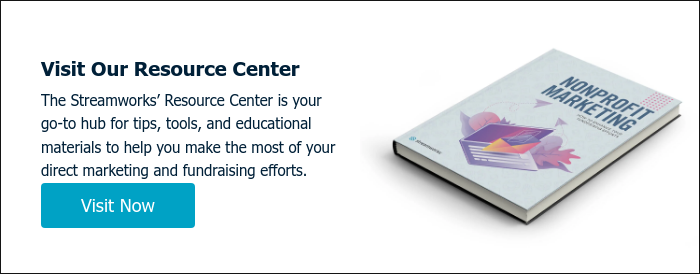Email Marketing for Nonprofits: Strategies to Boost Support and Giving
Streamworks Blog
.jpg?width=1000&height=500&name=shutterstock_662220520%20(1).jpg)
In today’s digital landscape, email marketing remains a powerful tool for nonprofits to engage supporters, share stories, and drive donations. Nonprofits email marketing is a crucial strategy for engaging supporters and growing donor relationships. As part of marketing for nonprofits, email marketing fits into broader efforts to enhance outreach, fundraising, and awareness. The key benefits of email marketing for nonprofits include cost-effectiveness, scalability, and measurable impact, making it an essential part of any growth strategy. Email marketing can help nonprofits enhance donor engagement, promote campaigns, and improve overall communication. In this article, we’ll cover key strategies for effective email marketing for nonprofits.
Whether a traditional promotional email or a fundraising-focused message, tailoring your approach can significantly impact your audience’s engagement. Here’s how to make the most of email marketing for your nonprofit.
Introduction to Email Marketing
Email marketing is one of the most effective ways for nonprofit organizations to connect with their supporters and drive meaningful action. By leveraging a thoughtful email marketing strategy, nonprofits can share their mission, promote fundraising campaigns, and nurture long-term relationships with donors. Email marketing allows organizations to reach supporters directly in their inboxes, providing a personal touch that can increase donations, improve supporter retention, and amplify the nonprofit’s message. Whether you’re just starting out or looking to take your email marketing to the next level, understanding the basics is key to building a strong foundation for your nonprofit’s outreach and fundraising efforts.
Traditional Promotional Email vs. Fundraising Email
While traditional promotional emails are often used to highlight products, services, or general updates, fundraising emails are crafted specifically to inspire action and encourage donations. The heart of a successful fundraising email is a clear call to action—such as “Donate Now” or “Support Our Mission”—paired with a compelling message that resonates emotionally with supporters. Fundraising emails often create a sense of urgency, motivating recipients to act quickly and become part of a community that supports the nonprofit’s cause. By focusing on storytelling and building a connection with supporters, nonprofits can ensure their fundraising emails stand out and drive real impact.
Traditional Promotional Email vs. Fundraising Email
Traditional Promotional Email: Typically focuses on event announcements, updates, or general information. It includes engaging visuals, short descriptions, and often a broad CTA, like “Learn More” or “Join Us.”
Fundraising Email: Designed to inspire action, often featuring one powerful story with a single, clear call-to-action (CTA), such as “Donate Now” or “Support Our Cause.” A fundraising email is often part of a larger fundraising campaign to raise awareness and solicit donations. These emails use targeted fundraising appeals to encourage immediate action and foster supporter engagement. Email fundraising appeals are a key tactic used by nonprofits to engage supporters and drive contributions. It connects emotionally with readers, offering a compelling narrative to drive contributions.
For example, a fundraising email example might share a beneficiary’s story, explain the impact of a donation, and include a direct link to give, clearly communicating the organization’s mission and motivating supporters to act.
Key Elements for Effective Emails
- Design: Use one image paired with concise, meaningful text. Include a compelling story or testimonial, and make sure the CTA is prominent and easy to follow. Crafting effective email subject lines is essential to increase open rates. Use personalized subject lines to boost engagement, and always optimize subject lines for mobile and clarity. A strong email subject is crucial to capture attention, and a concise email subject line is key for increasing email open rates.
- Mail Service Providers: These are examples of email marketing software used by nonprofits.
-
MailChimp: Offers robust analytics and a user-friendly interface. Great for managing lists and A/B testing. MailChimp also provides powerful email marketing features such as automation and detailed analytics to optimize campaigns.
-
Constant Contact: Provides ease of use with event management and seamless integration with social media. Constant Contact is a top email provider for nonprofits due to its reliability and nonprofit-focused tools.
-
HubSpot: Best for comprehensive marketing automation with advanced tracking and customization options.
-
Salesforce: Ideal for nonprofits looking for integration with CRM systems and detailed donor management features.
These are top email marketing platforms for nonprofits, offering a range of email marketing features to support effective campaigns. Tracking open and click metrics is essential to measure engagement, and monitoring click through rates serves as a key performance indicator for campaign success.
-
Custom Landing Pages: Enhance email effectiveness by linking to a custom landing page, allowing for better conversions and engagement tracking.
Designing Effective Emails
For nonprofit organizations, designing effective emails is essential to capturing attention and driving engagement. Start with a strong, personalized subject line that encourages recipients to open your message. Keep your content concise and engaging, focusing on a single, clear call to action that guides supporters toward your desired outcome. Make sure your emails are optimized for mobile devices, as many supporters will read them on their phones. Using email templates that reflect your nonprofit’s brand ensures consistency and professionalism, while a drag and drop editor makes it easy to create visually appealing emails without design expertise. Email marketing platforms like Constant Contact and Mailchimp offer a variety of user-friendly templates and design tools, helping nonprofits create emails that are both attractive and effective.
Monthly Topics for Nonprofit Emails
These approaches are a great way to engage supporters and increase donations.
- Appeal: Share urgent needs or opportunities to make a difference. Encourage continued support and invite your audience to continue supporting your organization. Use these emails to remind donors of their past support and the difference it has made.
- Thank You: Express gratitude for your support and update us on how donations are used. Sending thank you emails promptly after donations is essential to strengthen relationships and show appreciation for past support.
- Story Sharing: Share inspiring stories that illustrate the impact of donations and the work of your organization.
- Surveys: Gather feedback and insights from your audience.
- New Information: Keep your supporters informed about organizational news or upcoming events.
Building Your Email List
-
Website Subscribers: Encourage visitors to subscribe to your email list through easy sign-up forms or pop-ups. Strategically placing signup forms across your website and digital touchpoints maximizes list growth.
-
Events or Workshops: Collect emails at events through registration forms or on-site kiosks. Focus on collecting email addresses from event attendees and tracking event registrations to expand your list.
-
Reply Forms: Include sign-up options on physical reply forms, making it easier for supporters to stay connected. Integrate donation forms to collect supporter information and emails during the donation process.
-
Survey on Social Media: Ask questions or gather feedback with surveys on social media while providing a space for users to submit their email addresses.
-
Blogs and QR Codes: Embed QR codes in blogs, leading to a simple form for email subscriptions.
-
Referrals: Include email sign-up options in reply forms to encourage referrals from current supporters.
Send welcome emails or set up an automated welcome series to greet every new supporter or new supporters who join your list. Segment your list based on donor preferences and build strong donor relationships through personalized communication. Use targeted campaigns and clear calls to action to drive engagement and conversions. Leverage fundraising tools and integrate with other marketing channels and marketing efforts for comprehensive outreach. Use email outreach to nurture relationships and improve conversion rates for donations and event sign-ups.




